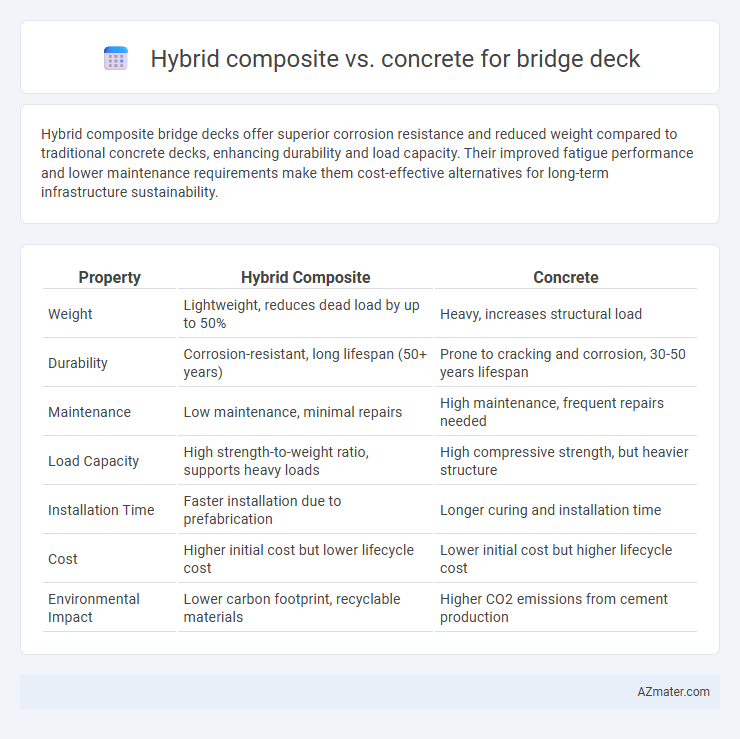Hybrid composite bridge decks offer superior corrosion resistance and reduced weight compared to traditional concrete decks, enhancing durability and load capacity. Their improved fatigue performance and lower maintenance requirements make them cost-effective alternatives for long-term infrastructure sustainability.
Table of Comparison
| Property | Hybrid Composite | Concrete |
|---|---|---|
| Weight | Lightweight, reduces dead load by up to 50% | Heavy, increases structural load |
| Durability | Corrosion-resistant, long lifespan (50+ years) | Prone to cracking and corrosion, 30-50 years lifespan |
| Maintenance | Low maintenance, minimal repairs | High maintenance, frequent repairs needed |
| Load Capacity | High strength-to-weight ratio, supports heavy loads | High compressive strength, but heavier structure |
| Installation Time | Faster installation due to prefabrication | Longer curing and installation time |
| Cost | Higher initial cost but lower lifecycle cost | Lower initial cost but higher lifecycle cost |
| Environmental Impact | Lower carbon footprint, recyclable materials | Higher CO2 emissions from cement production |
Introduction to Bridge Deck Materials
Hybrid composite bridge decks combine advanced fiber-reinforced polymers with traditional materials to achieve superior strength-to-weight ratios, corrosion resistance, and reduced maintenance costs compared to conventional concrete decks. Concrete remains widely used due to its high compressive strength, durability under heavy traffic loads, and cost-effectiveness in large-scale projects. Recent developments emphasize hybrid composites for enhancing structural performance while mitigating issues like cracking and weight limitations inherent in concrete deck systems.
Overview of Hybrid Composite Decks
Hybrid composite decks combine materials such as fiberglass, polymers, and steel to enhance strength-to-weight ratio and corrosion resistance compared to traditional concrete decks. These decks offer superior durability with reduced maintenance costs while maintaining structural integrity under dynamic loads common in bridge applications. Their lightweight nature allows for easier installation and reduces the overall dead load on bridge substructures, extending the service life of the bridge.
Overview of Concrete Bridge Decks
Concrete bridge decks offer exceptional compressive strength and durability, making them a preferred choice for heavy traffic loads and long-span bridges. Their inherent resistance to fire, weathering, and corrosion contributes to lower maintenance costs and extended service life. Advances in reinforced and prestressed concrete technology enhance load distribution and crack control, ensuring structural integrity under varying environmental conditions.
Material Properties Comparison
Hybrid composite materials for bridge decks offer superior strength-to-weight ratios and enhanced corrosion resistance compared to traditional concrete, reducing maintenance costs and extending service life. These composites provide higher tensile strength and flexibility, allowing better load distribution and resistance to cracking under dynamic loads. Concrete excels in compressive strength but is prone to chloride-induced corrosion and spalling, making hybrid composites a more durable option in aggressive environments.
Structural Performance Analysis
Hybrid composite bridge decks demonstrate superior structural performance compared to traditional concrete decks, exhibiting higher strength-to-weight ratios and enhanced fatigue resistance. Their improved energy absorption and reduced susceptibility to corrosion significantly extend service life while maintaining load-bearing capacity under dynamic and static loads. Finite element analysis often reveals lower deflection and stress concentration in hybrid composites, optimizing durability and reducing maintenance requirements over time.
Durability and Longevity
Hybrid composite bridge decks exhibit superior durability compared to traditional concrete, resisting corrosion, freeze-thaw cycles, and chemical attacks common in bridge environments. Their lightweight nature reduces structural stress and maintenance needs, extending service life beyond 75 years. Concrete decks, while initially cost-effective, often suffer from cracking, spalling, and rebar corrosion, which shorten lifespan and increase repair frequency.
Installation and Maintenance Requirements
Hybrid composite bridge decks offer rapid installation due to their lightweight structure and prefabricated panels, reducing on-site labor and traffic disruption compared to traditional concrete decks. Concrete decks require extensive curing time and heavy equipment, prolonging installation and increasing costs related to traffic management. Maintenance of hybrid composites involves less frequent repairs and resistance to corrosion, while concrete decks often demand regular sealing, crack repair, and resurfacing to address wear and environmental damage.
Environmental Impact Assessment
Hybrid composite bridge decks significantly reduce environmental impact by lowering carbon emissions and material waste compared to traditional concrete decks. Their lightweight nature decreases the energy consumption during transportation and installation, contributing to a reduced overall carbon footprint. Furthermore, hybrid composites offer enhanced durability, minimizing the frequency of repairs and replacements, which leads to long-term sustainability benefits in bridge infrastructure.
Cost Considerations and Life Cycle Analysis
Hybrid composite bridge decks typically offer lower life cycle costs compared to traditional concrete decks due to reduced maintenance and longer service life. Initial construction expenses for hybrid composites may be higher, but savings accrue from enhanced durability, corrosion resistance, and decreased repair frequency. Life cycle analysis reveals that hybrid composites minimize total cost of ownership by extending replacement intervals and reducing environmental impact through less frequent material sourcing and waste generation.
Case Studies and Real-World Applications
Case studies demonstrate that hybrid composite bridge decks offer superior durability and corrosion resistance compared to traditional concrete, leading to reduced maintenance costs and extended service life in marine and high-traffic environments. Real-world applications, such as the Tacoma Narrows Bridge and various highway overpasses, highlight improved load-bearing capacity and accelerated installation times with hybrid composites. Data from these projects confirm hybrid composites' potential to enhance structural performance while minimizing environmental impact due to their lightweight and sustainable material composition.

Infographic: Hybrid composite vs Concrete for Bridge deck
 azmater.com
azmater.com